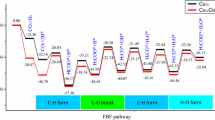Abstract
In this work, DFT simulation method was used to study the adsorption and dehydrogenation of ethanol on Cu/Cr2O3 catalyst. Firstly, the stable configuration of Cu4 cluster adsorbed on Cr2O3(001) surface was studied. Secondly, the adsorption and dehydrogenation of ethanol on Cr2O3(001) surface and Cu/Cr2O3 were calculated. A part of the charge transfers to Cr2O3 from Cu4 cluster after Cu4 cluster is adsorbed on Cr2O3(001) surface. It is easier for Cu/Cr2O3 catalyst to supply electrons than pure copper catalyst. Adsorption energy of ethanol molecules on Cr2O3(001) surface is 0.94 eV, suggesting a chemisorptions process. The adsorption energy of ethanol on pure copper is only 0.34 eV. The interface of Cu4 cluster and Cr2O3 provides the appropriate ethanol adsorption sites. The adsorption energy of the most stable configuration of ethanol is 0.80 eV, and the adsorbed ethanol molecule bonds with Cu atom. There is a charge transfer process among ethanol, Cu cluster and Cr2O3, which can enhance the adsorption stability of ethanol molecules.
Graphical Abstract
In this work, DFT simulation method was used to study the adsorption and dehydrogenation of ethanol on Cu/Cr2O3 catalyst. Firstly, the stable configuration of Cu4 cluster adsorbed on Cr2O3(001) surface was studied. Secondly, the adsorption and dehydrogenation of ethanol on Cr2O3(001) surface and Cu/Cr2O3 were calculated. A part of the charge transfers to Cr2O3 from Cu4 cluster after Cu4 cluster is adsorbed on Cr2O3(001) surface. It is easier for Cu/Cr2O3 catalyst to supply electrons than pure copper catalyst. Adsorption energy of ethanol molecule on Cr2O3(001) surface is 0.94 eV, suggesting a chemisorptions process. The adsorption energy of ethanol on pure copper is only 0.34 eV. The interface of Cu4 cluster and Cr2O3 provides the appropriate ethanol adsorption sites. The adsorption energy of the most stable configuration of ethanol is 0.80 eV, and the adsorbed ethanol molecule bonds with Cu atom. There is a charge transfer process among ethanol, Cu cluster and Cr2O3, which can enhance the adsorption stability of ethanol molecules.












Similar content being viewed by others
References
Prasad R (2005) Mater Lett 59:3945–3949
Agrell J, Boutonnet M, Melián-Cabrera I, Fierro JLG (2003) Appl Catal A 253:201–211
Colley SW, Tabatabaei J, Waugh KC, Wood MA (2005) J Catal A 236:21–33
Sanchez AB, Homs N, Fierro JLG, Piscina de la PR (2005) Catal Today 107:431–435
Zhang MH, Yu YZ (2013) Ind Eng Chem Res 52:9505–9514
Inui K, Kurabayashi T, Sato S (2002) Appl Catal A 237:53–61
Li XF, Jiang HX, Li GM, Zhang MH (2012) Ind Eng Chem Res 518:974–8978
Inui K, Kurabayashi T, Sato S (2002) J Catal 212:207–215
Zhang MH, Li GM, Jiang HX, Zhang JY (2011) Catal Lett 141:1104–1110
Zhang MH, Li RZ, Yu YZ (2012) Chin J Chem 30:771–778
Delley B (1990) J. Chem. Phys. 92:508–517
Monkhorst HJ, Pack JD (1976) Phys. Rev. B 13:5188
Sato Y, Akimoto S (1979) J Appl Phys 50:5285–5291
Sun K, Zhang MH, Wang LC (2013) Chem Phys Lett 585:89–94
Pantaleo G, Liotta LF, Venezia AM et al (2009) Mater Chem Phys 114:604–611
Philip GH, Nicholas CL, Wayne D et al (2000) Chem Mater 12:3113–3122
El-Shobaky GA, El-Khouly SM, Ghozza AM et al (2006) Appl Catal A 302:296–304
Liang CH, Ma ZQ, Ding L et al (2009) Catal Lett 130:169–176
Soon A, Todorova M, Delley B, Stampfl C (2006) Phys Rev B 73:1–12
Gomes JRB, Gomes JANF (2001) Surf Sci 471:59–70
Li RZ, Zhang MH, Yu YZ (2012) Appl Surf Sci 258:6777–6784
Hammer B, Norskov JK (2000) Adv Catal 45:71–129
Maurice V, Cadot S, Marcus P (2000) Surf Sci 458:195–215
Author information
Authors and Affiliations
Corresponding authors
Rights and permissions
About this article
Cite this article
Zhang, M., Huang, Y., Li, R. et al. A DFT Study of Ethanol Adsorption and Dehydrogenation on Cu/Cr2O3 Catalyst. Catal Lett 144, 1978–1986 (2014). https://doi.org/10.1007/s10562-014-1356-8
Received:
Accepted:
Published:
Issue Date:
DOI: https://doi.org/10.1007/s10562-014-1356-8




